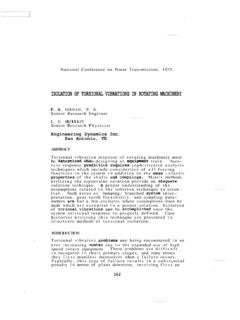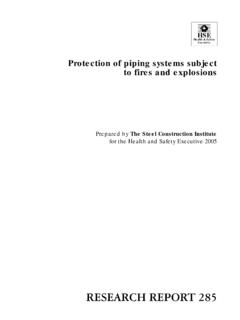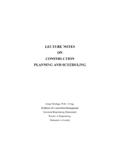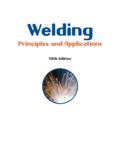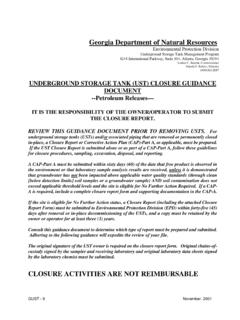Transcription of Manager of Engineering Engineering Dynamics …
1 piping VIBRATION AND STRESS by J. C. Wachel Manager of Engineering Engineering Dynamics incorporated San ~ntonio, Texas J. C. Wachel holds an MSME degree from the University of Texas. He has been with outhwest Research Institute ince 1961. His activities ave centered in the fields f vibration, pulsation, ynamic simulation, acous- ics, and fluid flow prob- ems. He has developed rocedures which are used to ontrol piping vibration in ystems subjected to acous- tical pulsations. He also was instrumen- tal in the development of techniques for predicting and controlling compressor man- ifold vibrations. In recent years, he has specialized in the analysis of vibration and failure problems in rotating machinery.
2 He is a member of Tau Beta Pi and Pi Tau Sigma. INTRODUCTION To even a casual observer, a most ob- vious effect of pulsations is that it forces piping and other plant systems into sustained vibrations and, under some condi- tions, the vibrations can cause fatigue failures at critical, high bending stress regions in the mechanical systems. The existence of such pulsation-induced me- chanical vibrations suggest two obvious approaches to control and one approach which is perhaps less obvious. These are: 1. Supply mechanical restraints which will prevent movement of the pipe. 2. Eliminate or control the pulsa- tions. 3. Eliminate the coupling of pul- sations as forces into the piping .
3 While each of these approaches are valuable, no one approach is optimum in all cases and any one by itself can prove excessively expensive. The cost of me- chanically restraining compressor piping or overhead plant piping , for example, soon causes the engineer to seek help from other control approaches. A similar situ- ation exists with pulsation control. If pulsation suppressors are designed to eliminate "all" pulsations ( , to a level that any piping system could be utilized) then it is soon found that pres- sure vessels of excessive size are re- quired. The concept of decoupling the pulsa- tions from forcing the mechanical system into vibration will be discussed in a later section, but basically it involves control- ling the location of bends, constrictions and piping discontinuities relative to the pulsation standing waves.
4 It is difficult, for example, to excite an infinitely long, straight, constant diameter pipe into vi- bration from internal pulsations. In more realistic piping configurations, however, there are also things that can be done to minimize pulsation shaking forces. These, too, will be described later in this chap- ter. While each of the above approaches are useful in controlling known piping vibra- tion problems, two fundamental questions remain which can drastically reduce the time and effort involved in field fixes: 1. Are you aure the vibrations are excessive and require reduction? 2. What can you do at the design stage to prevent the problem? Again, these will be dealt with in subsequent sections involving "Criteria", "Field Testing" and "Simulation Techniques for Predicting Pulsation Induced Vibra- tions".
5 piping VIBRATION AND STRESS CRITERIA One of the major reasons why pulsation control alone should not be used to control flow-induced piping vibrations lies in the fact that there are no pulsation criteria which can be reliably used for preventing vibrations. In spite of the fact that many such criteria have been evolved, it is not pulsations per se which are the problem, but rather the dynamic stress levels which result in the pipe wall. Whenever vibra- tory stress exceeds the endurance level of the material, piping failure is imminent. By similar argument, it can be seen that vibration amplitude criteria for piping systems are likewise dangerous and, again, are fundamentally the wrong approach unless consideration is given to the con- figuration and dimensions of the piping system being considered.
6 The technical literature is replete with vibration cri- teria for plant piping , machinery, and structural systems which specify "allow- able" vibration amplitudes as a function of frequency as shown in Figure l. Such criteria are based largely upon the experi- ence of field personnel operating or work- ing with such equipment. While they may be applicable in a statistical sense to average or typical piping , they are funda- mentally incorrect because they do not con- sider the configuration involved. As such, they introduce considerable risk when used in evaluating any specific piping system as they may result in a degree of design confidence which is unwarranted by the de- sign procedure used.
7 Although the criteria are based on typical or average conditions, they do not normally contain such a warning or supply a definition of the limits of what constitutes average or typical. The problem with any such criterion is not so much that it is not applicable to many plant systems but rather the cost of failure and downtime in those cases in which it does not work. While the statis- tical data from which the criterion was generated proves it works in most cases, the risk that it may not work for the next design should often dictate a more thorough analysis. Note that the criterion as pre- sented does not differentiate between a stiff compressor manifold system and a flexible scrubber lead line.
8 If the crite- rion is sufficiently conservative to pro- tect the compressor manifold system, it will normally be overly conservative for the lead line. It should also be noted that the stress level in a pipe is a func- tion of physical distortion only ( , strain), and is not a function of frequency for the general case. If frequency is to be one of the controllable allowables in vibration amplitude, it must include cogni- zance of the type of piping span involved and its resonant frequency and mode shape, as discussed below. Vibration Frequency, Hz Figure 1. Allowable piping Vibration Levels Note: Indicated vibration limits are for average piping system constructed in accordance with good Engineering practices.
9 Make additional allowances for critical applica- tions, unreinforced branch connections, etc. Stress Predictions in Idealized Pipe Spans Table 1. Constant Factors for Calculating the Stress Per Mil (s/y) in For any span configuration, it is fea- sible to calculate the stress which re- sults from a given deflection (stress per mil, or s/y), providing the end conditions and vibratory mode shape (deflection pro- file) are known. The general equation relating maximum stress in a pipe to the maximum deflection along the span is given below for the low- est vibratory resonance mode (note that the maximum stress and maximum deflection are generally not at the same point): Where : s = Stress at maximum stress point, psi (lb/in2) E = Elastic Modulus.
10 Lb/inL D = Diameter, in = d2y/dx2 evaluated at maximum stress point y = Deflection, mils, at maximum deflection point Q. = Span length, in L = Span length, ft A = Frequency factor for steel pipe, this becomes = 3 psi stress/mil Y deflection Solution of this equation for several span configurations is given in Table 1. This table can be used either: 1. To determine the stress resulting from a given deflection (at the maximum deflection point) or 2. To establish maximum allowable deflections. Non Ideal Beams Various Pipe Spans Beam Type ~ixed-F ixed Cant ilever Simply Supported Fixed/Simply Supported Table 1 assumes idealized end condi- lowest resonant frequency of the span can tions.





